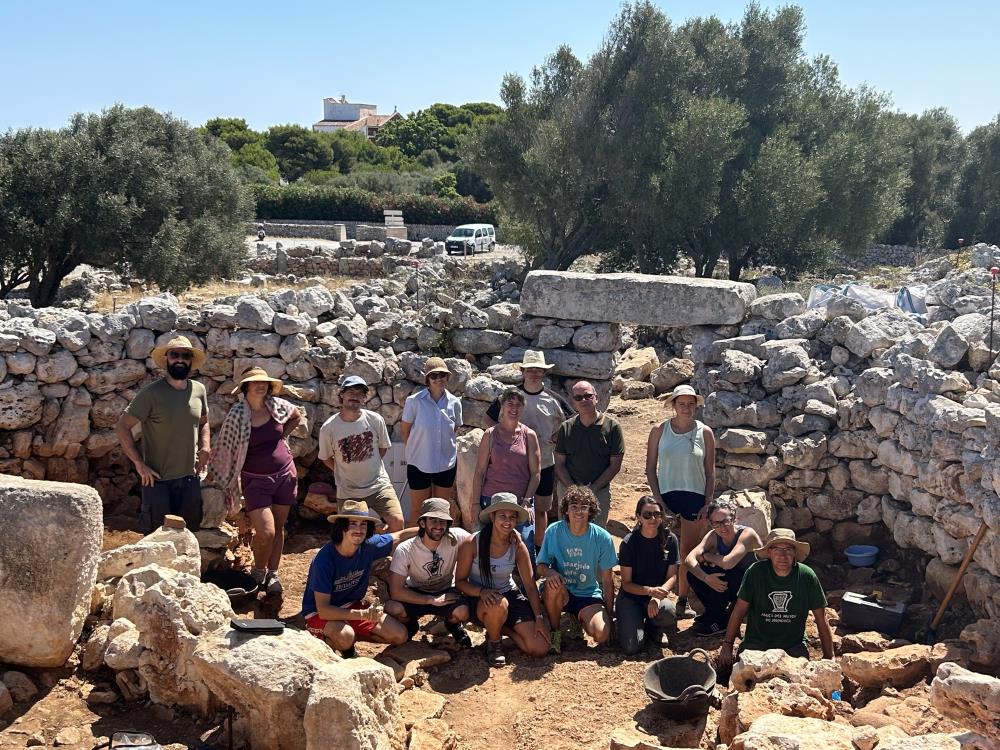 Amics del Museu de Menorca presented the new features of the 2023 excavation campaign in Torre d'en Galmés, the fifth in the northern part of the settlement. Between the 3rd and 21st of July, the team is working in this area together with students from different universities in Spain and volunteers from Menorca. Simón Gornés, conseller for the Environment, Biosphere Reserve and Cooperation, and the councillor for Cultural Affairs of Alaior Town Council, Eva Petrus, were the authorities present. They were accompanied by the directors of the project, the archaeologists Carlos de Salort and Borja Corral, and the president of Amics del Museu de Menorca, Cecília Ligero.
Amics del Museu de Menorca presented the new features of the 2023 excavation campaign in Torre d'en Galmés, the fifth in the northern part of the settlement. Between the 3rd and 21st of July, the team is working in this area together with students from different universities in Spain and volunteers from Menorca. Simón Gornés, conseller for the Environment, Biosphere Reserve and Cooperation, and the councillor for Cultural Affairs of Alaior Town Council, Eva Petrus, were the authorities present. They were accompanied by the directors of the project, the archaeologists Carlos de Salort and Borja Corral, and the president of Amics del Museu de Menorca, Cecília Ligero.
The excavation project at Torre d'en Galmés is focused on a group of domestic spaces and annexed structures located in the northern part of the settlement, between two of the three talayots, which bear witness to the oldest phase of occupation of the settlement. Since 2021, the occupation levels of one of these domestic structures, the most fertile in terms of material remains that belonged to the last inhabitants of the house, have been excavated. Although several houses have already been excavated in the settlement with a well-defined pattern, this one has a slightly different distribution and shape to those that have been documented.
The different summer campaigns in this house have been marked by recurrent findings of human remains that have been exhumed by the archaeologist Elena Sintes. At the moment, they are in the process of being studied and it is impossible to specify anything. Between the five archaeological campaigns, the remains of between five and six individuals have been located, the last one this year.
It is clear that finding human skeletons inside a domestic space without any kind of burial is not something normal. These would be people of different genders and ages, and their specific study will make it possible to refine how and when the final episode of the dwelling took place. For the moment, while awaiting these results, only one of the skeletons found has been dated, indicating that it died between 370 and 201 BC.
It should be noted that this is not the first time that Amics del Museu has found human remains. Between 2005 and 2010, in one of the houses in the southern part of the settlement, Circle 7, a group of individuals who died in anomalous circumstances in the 3rd century BC were also documented. These dates would mark the abandonment of the dwelling until the present day, with the exception of some specific occupations that need to be analysed in greater detail.
Indigenous crockery and silos
In addition to these surprising human remains, a very interesting collection of indigenous and Punic Ebusitan crockery has been found. During the 4th and 3rd centuries BC, the everyday life of the Menorcans was marked by trade with the Carthaginians, especially from Ebusus, modern-day Ibiza.
Also of great interest is the discovery of different silos or deposits excavated in the rock, which are in the process of being excavated and which could provide a great deal of information on the earlier phases of use of the area.
All these findings will be presented at the visiting day on Thursday, July 20, at Torre d'en Galmés.
The archaeological project of Amics del Museu de Menorca is possible thanks to the funding of the Consell Insular de Menorca, the Alaior Town Council and the members of the association. It also has the scientific support of Boston University, the Royal Institute for Cultural Heritage of Belgium, the Escuela Superior de Conservación y Restauración de Bienes Culturales de Cataluña, among others.